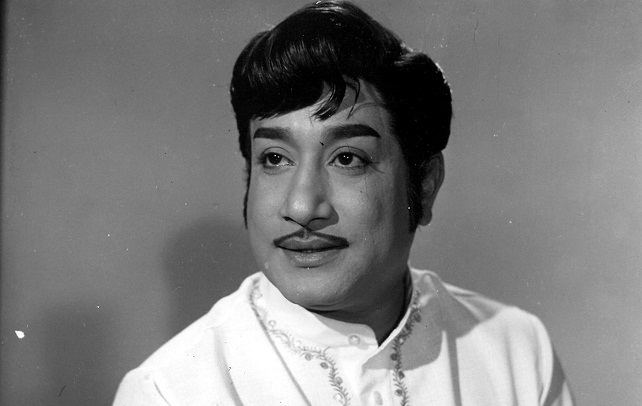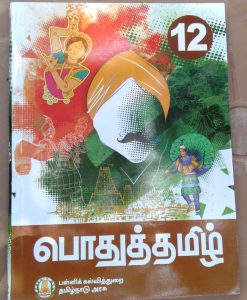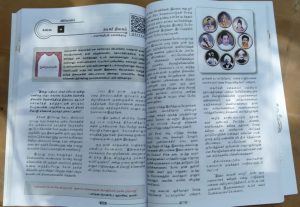
Textbook for Tamil goes beyond literature; delves into films, history, science

After Tamil Nadu’s opposition against the three language policy in schools, another controversy has erupted — and this time too, guns are being trained at an alleged ‘saffronisation’.
In what is being alleged as the BJP government’s move to push its Hindutva agenda, an illustration on the cover of the Class 12 Tamil book showed Tamil poet Bharathiar sporting a saffron-coloured turban. The poet used to wear only white turbans.

This has irked Tamil scholars and nationalists, who have interpreted the illustration as an arm-twisting move by the Centre in appropriating Bharathiar as a Hindutva icon.
Opposition parties in Tamil Nadu, like the DMK, have already started training their guns at the state government, while the ruling dispensation is yet to come up with an explanation.
However, the illustrator in an interview to a Tamil channel claimed that the saffron, white and green colours used in the image were “depictive of the Indian flag”. He said there was “no intention to change the colour of Bharathiar’s turban from white to saffron.”
Cinema in Tamil syllabus
However, many who raised questions on the illustration have overlooked the content of the book. Under the new syllabus, Class 12 students are being exposed to various fields, besides the Tamil language. It contains lessons from various fields such as literature, environment, science, history and even one about cinema.
For the first time, the Tamil book features a lesson on the life of popular actor Sivaji Ganesan. Until now, except for MG Ramachandran, the actor-turned-politician who later went on to become the chief minister of Tamil Nadu, no other film star’s life was included in school textbooks.

Interestingly, Ganesan has played the role of Bharathiar in song sequences like ‘Velli Panimalaiyin’ from ‘Kappalottiya Thamizhan’ (1961) and ‘Sindhu Nadhiyin Misai’ from ‘Kai Kodutha Deivam’ (1964).
The lesson has been adapted from the book ‘Chidambara Ninaivugal’ by popular Malayalam poet Balachandran Chullikkad. Originally published in Malayalam as ‘Chidambarasmarana’, the poet’s memoir was translated into Tamil by KV Shylaja and has been published by Tiruvannamalai-based Vamsi Books in 2003.
Read more: Why this anti-Hindi fervor in Tamil Nadu
In the lesson, Chullikkad speaks about his meeting with Ganesan in Chennai. While having a conversation with the poet, the actor suddenly stood up and re-enacted a scene from one of his films, ‘Kattabomman’. He delivered the same dialogues — which got huge response from the audience during the film’s release — after many years, without any stumbling.
After the release of his memoir, that chapter has been published by various other magazines.
Speaking to The Federal, Shylaja said she was taken by surprise when she saw the work appear in her daughter’s Class 12 textbook. “That was the first book I translated from Malayalam.”
She said it was due to her passion for translating Chullikkad’s memoir that she learnt Malayalam. She has translated over 15 Malayalam books.
“That particular chapter was first published in Malayalam magazine ‘Aranyam’ by Sripathi Padmanabhan. After having heard about the article, me and my husband, Bava Chelladurai, met Chullikkad and invited him to Tiruvannamalai,” she said. There, the poet gave lectures on poetry and also gave Shylaja his memoir.
“It has been 16 years since I started translating Malayalam. Still, we are receiving letters from readers, appreciating the book. The book became a best-seller because of the poet’s ‘openness’ about his life.”
‘Appreciate cinema as art’
Meanwhile, former school education secretary T Udayachandran, the IAS officer behind the formation of the new syllabus, told The Federal that the aim of including a chapter on films was to make the students “appreciate film as an art and science form”.
“Whatever we like to have in Tamil, should be available in Tamil. That is our main objective. Hence, we included chapters from various fields other than literature. Director Balu Mahendra always insisted that schools must teach cinema as a subject. The chapter also talks about Charlie Chaplin’s films,” he said.
Asked about the feedback from teachers, Udayachandran admitted that there were some hiccups among parents and teachers initially.
“We have given capacity-building training to the teachers. Also, we have given the list of reference books at the end of every chapter. Though we get positive response from intellectual side, teachers should also work hard when it comes to their subjects,” he said.


